my country's own brand cars are gradually gaining a carbon advantage, and it is recommended that leading car companies pay more attention to reducing carbon in their models.
What is the carbon emissions situation of the automobile industry, an important pillar of the national economy? my country's self-owned brand cars are gradually gaining a carbon advantage. The carbon footprint of self-owned brand models is at the middle level and lower than the industry average. It is already better than the German, American and British models, but higher than the French, Japanese, and Korean models. The car series is dominated by small and medium-sized cars. This is what the reporter learned from the carbon disclosure platform of China's automobile industry chain.
In addition, the carbon footprint level of pure electric vehicles is significantly better than that of fuel vehicles. Judging from the average of different fuel types, compared with gasoline vehicles, electric vehicles have obvious life-cycle carbon emission reduction advantages, which is 37.8% lower than gasoline vehicles. As the penetration rate of new energy vehicles in my country increases year by year, the carbon emission reduction advantages of pure electric vehicles will become more obvious.
The reporter learned that since the launch of the China Automobile Industry Chain Carbon Publicity Platform (hereinafter referred to as "CPP"), as of April 30, the platform has publicized the carbon footprint data of 61 car companies and more than 6200 models, including 4211 gasoline vehicles. There are 1457 pure electric vehicles, and the rest are plug-in hybrid vehicles, regular hybrid vehicles and a small number of diesel vehicles, covering mainstream models on the market. In fact, with the launch of "CPP", the carbon footprint data of Chinese automobiles has gradually become public, quantified and transparent.
Pure electric vehicles have obvious advantages in carbon emission reduction, independent brands gradually have carbon advantages
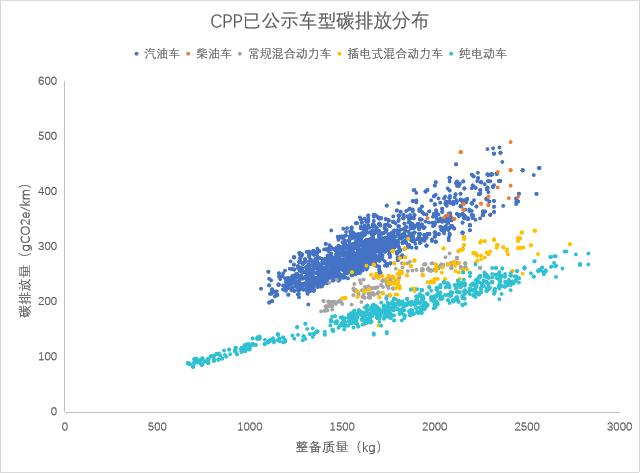
Figure 1 Carbon emission distribution of CPP announced models
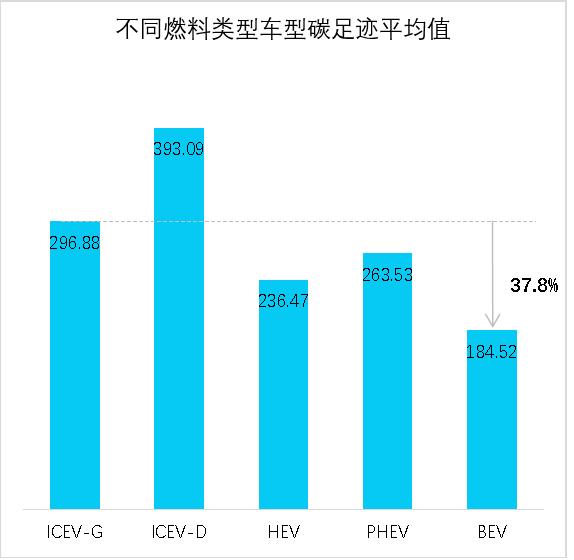
Figure 2 Average carbon emissions of CPP announced models
CPP is the world's first carbon footprint information disclosure platform for the entire automobile industry chain. According to statistics published by CPP, it can be seen from the average carbon footprint distribution map among different models that the carbon footprint of self-owned brand models is at the middle level and lower than that of the industry. The average value is already better than that of German, American and British models, and higher than that of French, Japanese, and Korean models, which are mainly small and medium-sized cars. Zhang Ting, director of China Automobile Carbon (Beijing) Digital Technology Center Co., Ltd., pointed out in an interview with a reporter from China Environment News that this is due to the wide variety of self-owned brand models, including large, medium and small models, and the complete range of cars, SUVs and MPVs; On the other hand, there are fewer new energy models in Korean and French countries, and most of them are small and medium-sized models, resulting in a low carbon footprint.
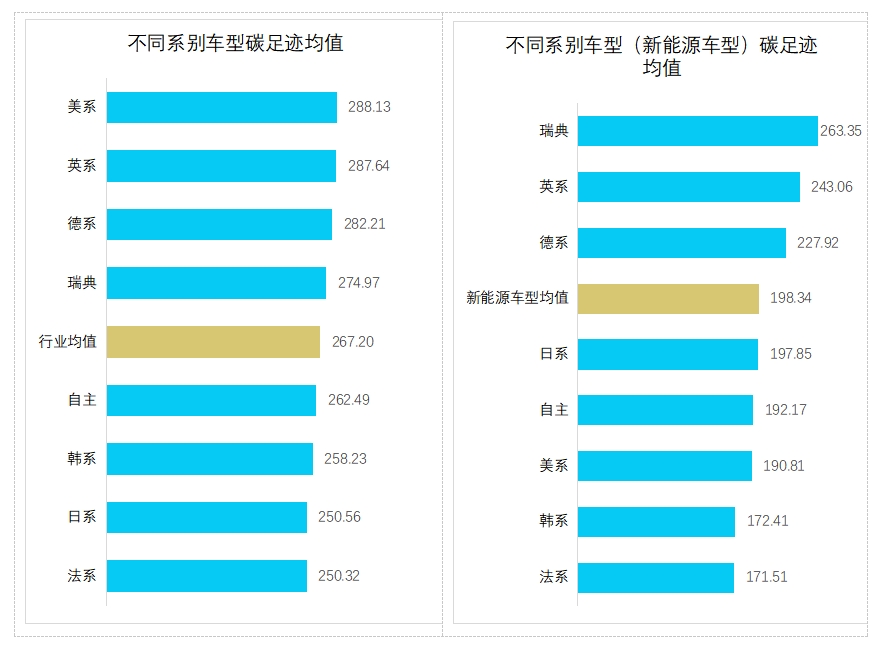
Figure 3 Average carbon footprint of different models
CPP also compared the carbon footprints of different enterprise models, and found that the differences were obvious. It pointed out that the development of low-carbon models of the three major central enterprises, FAW Group, Dongfeng Group and Chongqing Chang 'an, has a long way to go.
According to CPP platform data, the carbon footprints of different enterprise models differ significantly. The average carbon footprints of the models of the top ten domestic automobile groups are shown in Figure 4. Since BYD Automobile only produces new energy models (plug-in hybrid and pure electric), its average carbon footprint has the lowest; among the remaining nine companies, GAC Group, Geely Holdings, and Dongfeng Group performed better, while Changan Group and BAIC Group performed relatively poorly.
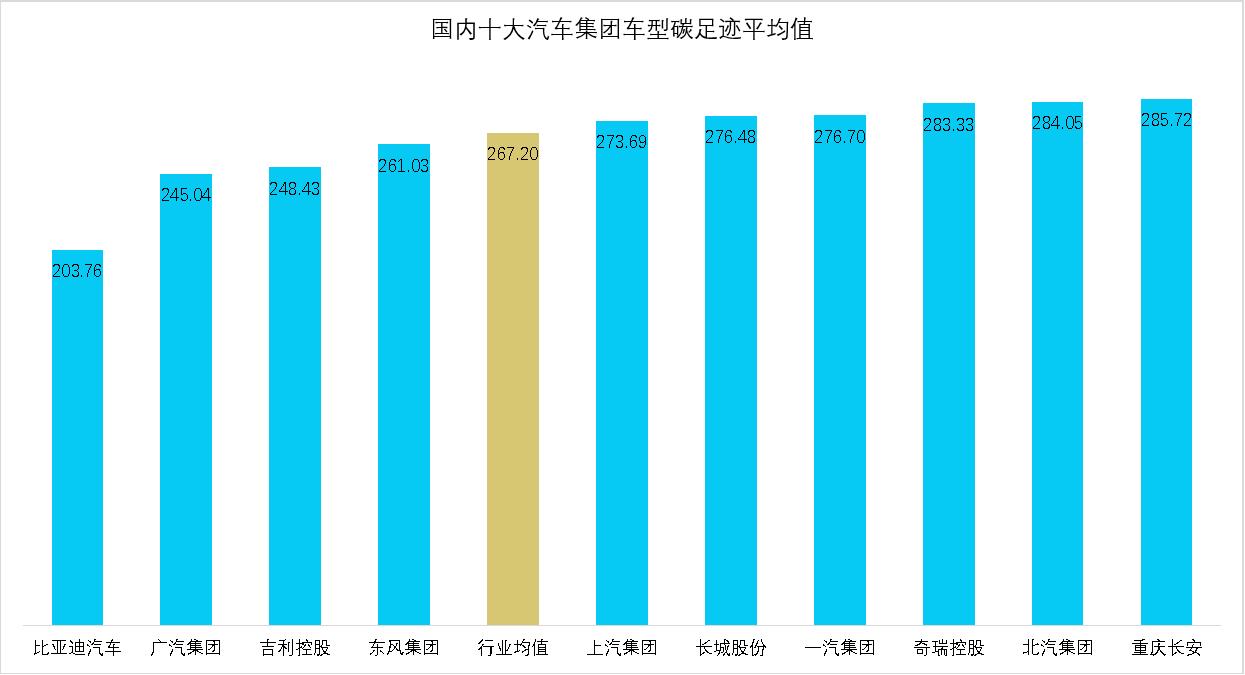
Figure 4 Average carbon footprint of models of top ten domestic automobile groups
Within the same automobile group, due to differences in brand positioning and model planning, the average carbon footprints of models of various brands and subsidiaries also differ. For example, BYD's Alphabet series models are mostly small and medium-sized pure electric vehicles with a low carbon footprint, which lowers the overall carbon footprint level. GAC Ai 'an only produces new energy models with a low carbon footprint; GAC passenger cars have many types of models, mainly gasoline vehicles, with a high overall carbon footprint. BAIC New Energy produces pure electric vehicles with a low carbon footprint; Beijing Hyundai produces more small and medium-sized models with a low carbon footprint; Fujian Benz and BAIC Off-Road models have higher fuel consumption and larger carbon footprints, which has increased the Group's carbon footprint. Level. Avita Technology produces pure electric vehicles with a relatively low carbon footprint; Changan Ford (including Changan Lincoln) produces more medium and large models with a high carbon footprint, thus raising the level of carbon footprint.
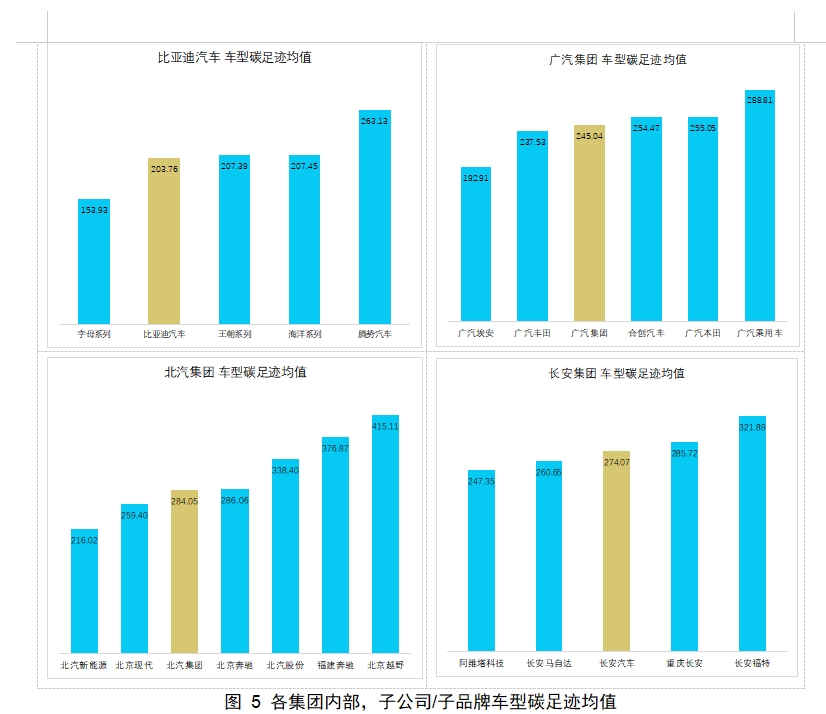
There are also differences in the average carbon footprints of models among FAW Group, Dongfeng Group and Chongqing Chang 'an. FAW Group has not established a separate new energy vehicle company/brand. Dongfeng Group and Chongqing Chang 'an both have independent new energy vehicle companies/brands. For example, Dongfeng established Lantu Automobile. Chongqing Chang 'an has established Chang' an Qiyuan, Avita Technology and Deep Blue Automobile, etc., and the types are also relatively rich. Due to the different positioning of various new energy brands, the carbon footprint gap is relatively large, such as Dongfeng Motor (Dongfeng Nano), Lantu Automobile and Avita Technology has a large carbon footprint gap.
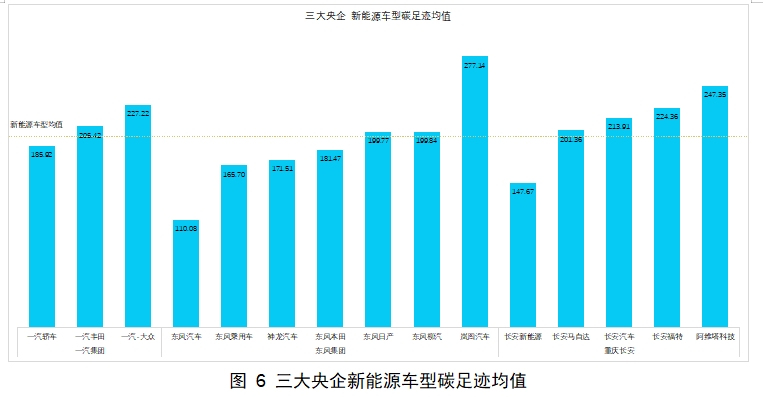
The carbon footprints of different models vary greatly, which is closely related to brand positioning
The average carbon footprint of new energy vehicle companies is shown in the following figure. The difference in the carbon footprint of models is large, which is mainly related to brand positioning and model planning. For example, Lantu Automobile, Celis Automobile and Ideal Automobile, which are positioned as high-end, produce more medium and large SUVs., MPV models have a higher carbon footprint, while Chery New Energy and Changan New Energy, which are positioned as small and medium-sized vehicles, have a lower carbon footprint; there is no obvious gap between new car-building forces and new energy brands of traditional car companies.
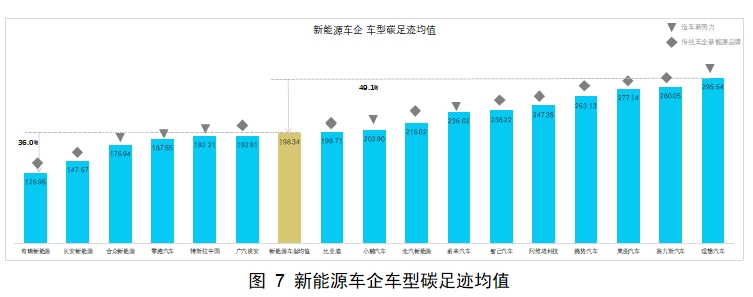
In addition, judging from the average carbon footprints of different model years, the difference in the carbon footprints of models is large, which is mainly related to brand positioning and model planning; the average carbon footprints of Geely Holdings 'new energy models from 21 to 23 are relatively similar, without much change; BYD's 22 model has a higher carbon footprint, and a lower carbon footprint for 23 model; the average carbon footprint for 23 models has a higher carbon footprint, which should be related to its new car launch plan.
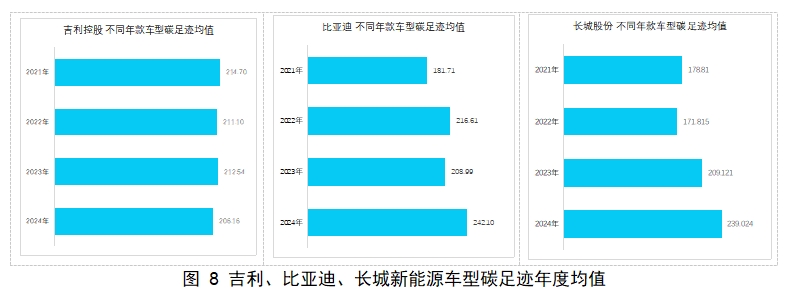
Zhang Ting introduced that by summarizing and comparing the average carbon footprint of publicly announced companies with the industry average, the proportion of each company's model carbon footprint being lower than the industry average is as follows. The carbon footprint of all products of Dongfeng Motor (Dongfeng Nano), Cyrus Blue and other companies are lower than the industry average; the carbon footprints of all products such as Fujian Benz and Chery Jaguar Land Rover are higher than the industry average, and there is still a lot of work to be done by automobile companies to reduce carbon emissions.
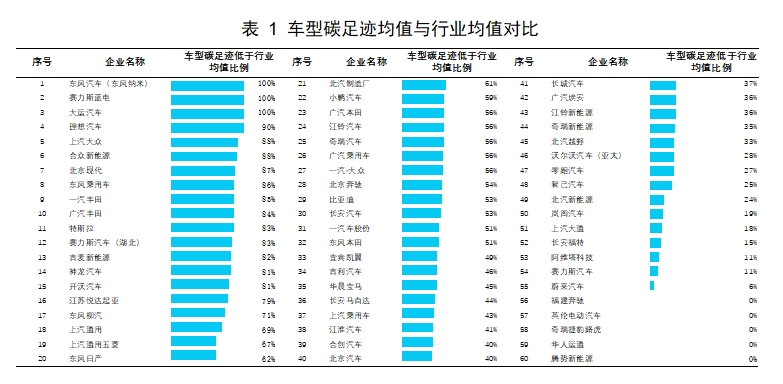
According to current statistical data, the CPP platform has carried out publicity on the carbon rating of automobile products. The carbon footprint levels of models are divided into 5 levels according to different fuel types, which are level 1 "low carbon +" and level 2 "low carbon-"., level 3 "medium", level 4 "high carbon-" and level 5 "high carbon +", of which only the top 20% of models can reach level 1 "low carbon +". Among the publicly announced models, the situation of some enterprises 'Level 1 logo models is as shown in the figure below. GAC Toyota and FAW Toyota performed best, with Level 1 logo models accounting for 79%, followed closely by BYD, accounting for 67%.
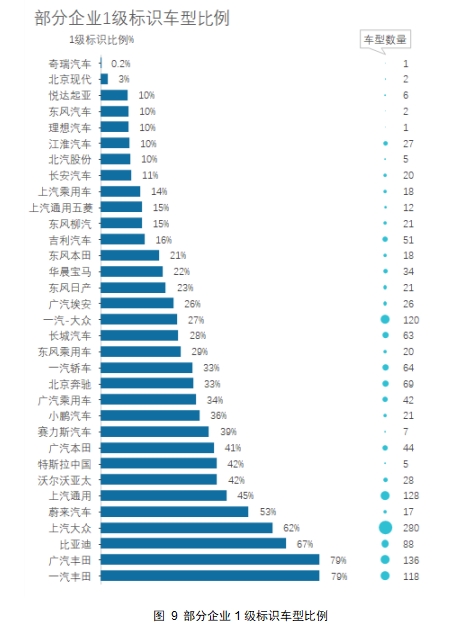
Leading car companies should pay more attention to carbon reduction in models
Judging from the average carbon footprint of corporate bicycles, among the high-selling car companies in March, BYD, Tesla and SAIC-GM-Wuling produced more new energy models, with a smaller carbon footprint for bicycles; judging from the total life cycle carbon footprint of models sold in March, since its model has the highest sales volume, the total carbon footprint is also the largest, reaching 9.22 million tons; Compared with SAIC Volkswagen, Tesla, Great Wall Motor and SAIC Passenger Cars, which have close sales, Tesla's bicycle carbon footprint is low, and its total carbon emissions are the smallest among the four companies. Therefore, the leading car companies should pay more attention to reducing carbon emissions in models.
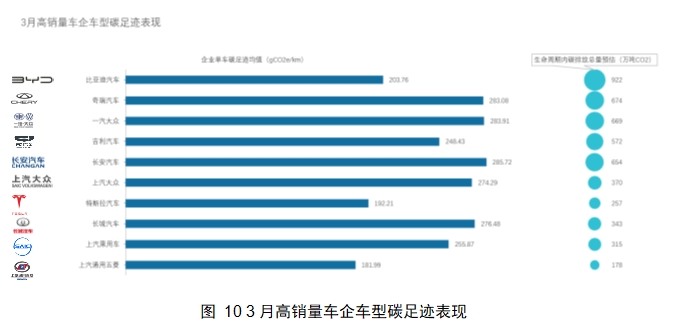
So, what is the carbon footprint performance of different models?
The reporter learned that 1. In terms of pure electric vehicles, in March 2024, except for AION S and Tang New Energy, the carbon footprints of the other eight models are slightly higher than the industry average. Average; except for Hongguang MINI EV, which is a Level 2 logo, the remaining nine models are all Level 1 logos.
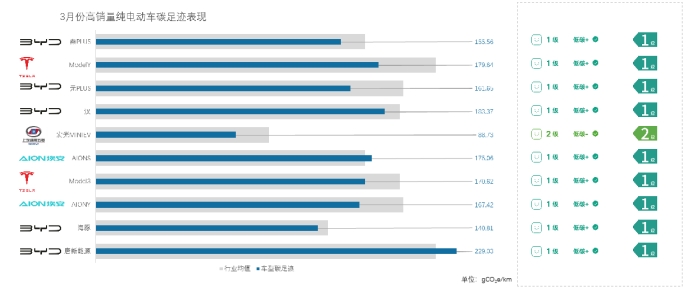
2. Plug-in hybrid vehicles (including extended range), carbon footprint identification of high-selling plug-in hybrid vehicles (including extended range) in March 2024. Except for Song Pro New Energy and Tengshi D9, the carbon footprints of the remaining 8 models are higher than the industry average. Average, the carbon footprints of the remaining 8 models are lower than the industry average; Qujie M7 is a level 3 identification, Song Pro New Energy, Ideal L7, Ideal L9, and Ideal L8 are level 2 logos, and the rest are level 1 logos.
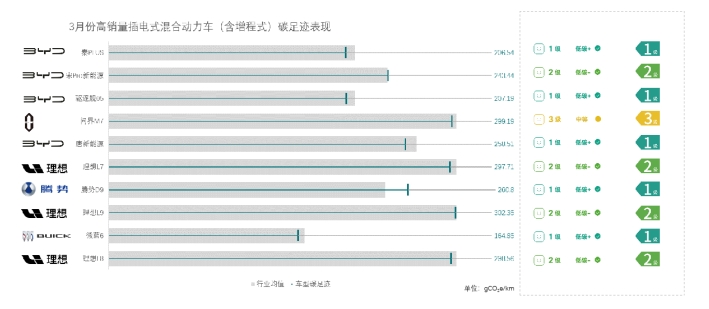
3. Fuel models. In March 2024, the carbon footprint of high-selling fuel models showed that the carbon footprint of the Audi A6L was higher than the industry average, and the carbon footprint of the other nine models was lower than the industry average; the Audi A6L was a Level 4 logo, and the Xuanyi and Changan CS75 PLUS and Fenglanda were Level 2 logos, and the rest were Level 1 logos.
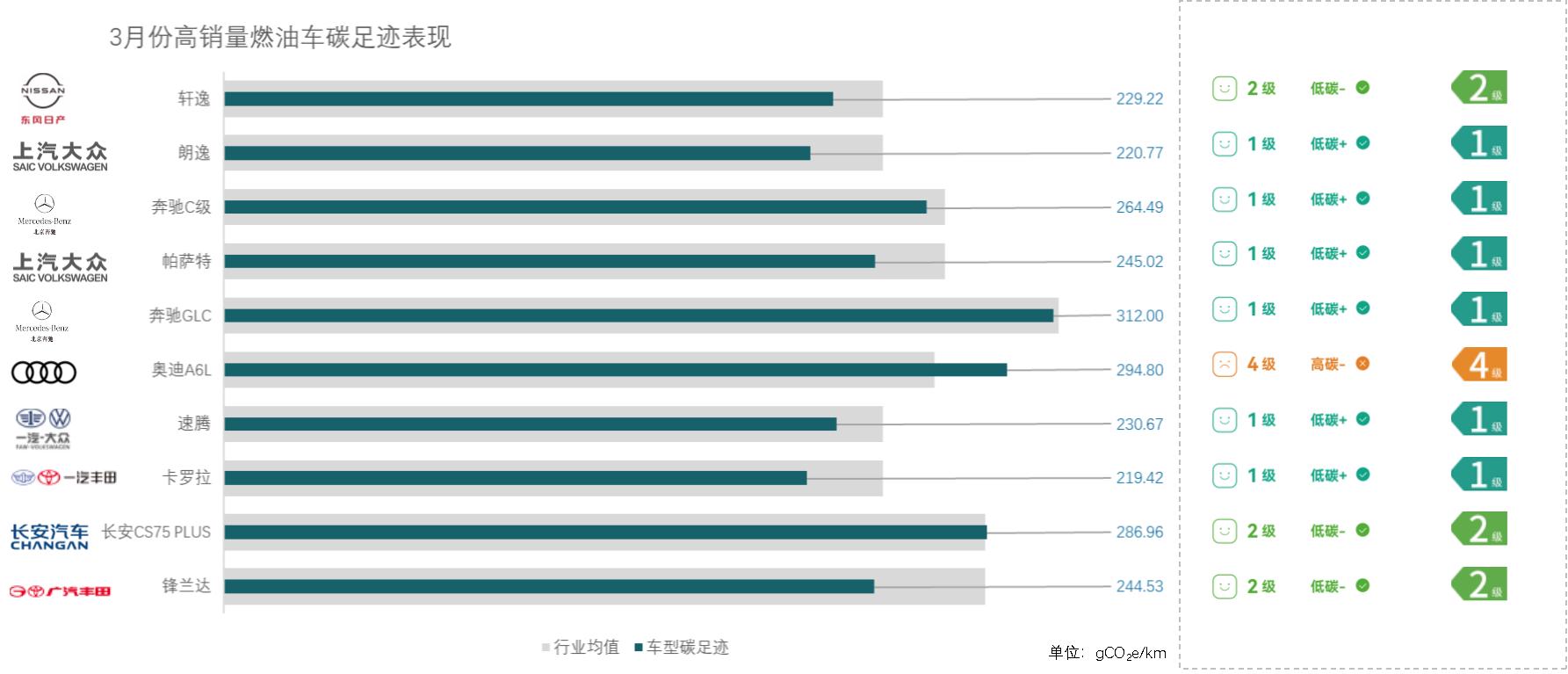
4. The carbon footprint distribution of luxury brand models and luxury brand B-class gasoline SUV models is only lower than the industry average, and the Volvo XC60 is slightly higher than the industry average.
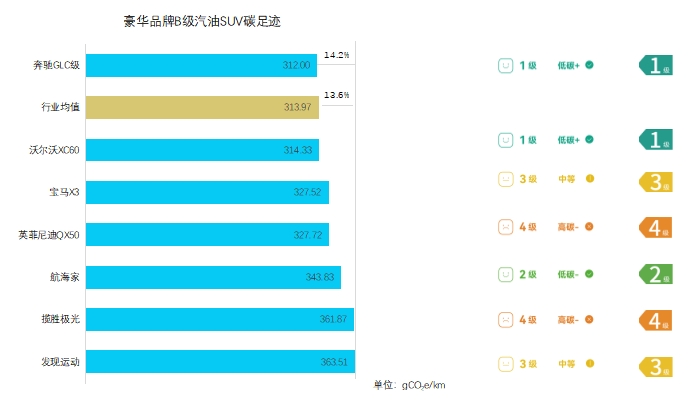
In addition, CPP also specifically counted the new car models. Among the new car manufacturers, the carbon footprints of NIO ET5 and ET7 are slightly higher than the industry average, and all three models are Level 1 logos; The carbon footprints of the three models of Xiaopeng are lower than the industry average. Xiaopeng P7 and Xiaopeng G6 are Level 1 logos, and Xiaopeng G3 are Level 3 logos; the carbon footprints of the three ideal models are all lower than the industry average, and are all Level 2 logos; The carbon footprint of Celis's M5 is slightly higher than the industry average, which is a level 1 mark. The carbon footprint of the M7 is slightly lower than the industry average, which is a level 3 mark.
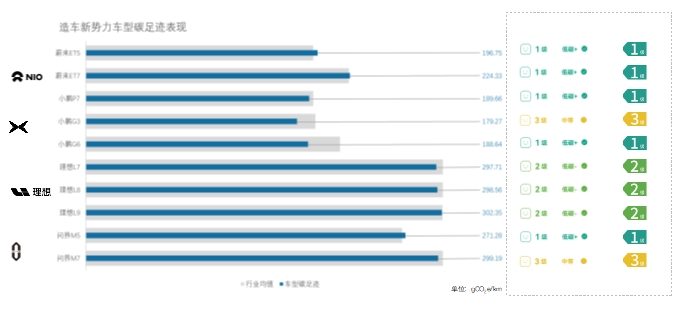
The low-carbon transformation of the automobile industry has a long way to go. CPP said that it will continue to track the carbon footprint and latest development results of the automobile industry to jointly create a "green, low-carbon and beautiful China" production and lifestyle. The China Automobile Industry Chain Carbon Publicity Platform (CPP) will empower low-carbon with digitalization, help the Chinese automobile industry improve automobile carbon data, consolidate the level of automobile carbon emission management, promote international mutual recognition of carbon data, and outperform "carbon emissions" as the core. A new track for international trade.







